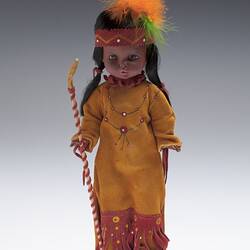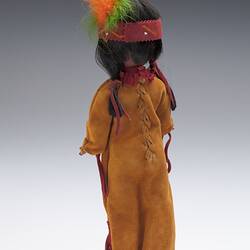Summary
Note: This object is a cultural stereotype. Such representations are not condoned by Museums Victoria which considers them to be racist. Historical distance and context do not excuse or erase this fact.
National doll produced to represent a North American Indigenous woman, which was purchased by Monica Gates at Niagara Fort in 1980. Located at the mouth of the Niagara River, near the US-Canadian border, Fort Niagara was an active military post well into the 20th century. Built by the French in 1726, it was captured by the British in 1759, who yield it to the US in 1979. In 1813 the British recaptured the Fort, although they were forced to cede it again in 1815. Throughout the Fort's history the Iroquois, Six Nations or Haudenosaunee 'People of the Long House' (as they call themselves), played an important role in the region and in the power struggles between French, British and American peoples.
The Haudenosaunee are an association of six Indigenous North American peoples created circa 1142-1600, originally composed of five groups the Mohawks, Oneidas, Onondagas, Cayugas and Senecas, the Tuscaroras joined in 1722. It is one of the earliest continuing participatory democracies on earth and is believed to have provided a model for the US Constitution. Recognised as a sovereign nation by both the Canadian and US Governments, in 2010 the Haudenosaunee made international headlines after their lacrosse team was refused entry into Britain on their Haudenosaunee passports, the British Government insisting they travel on US or Canadian passports. The refusal of the Haudenosaunee to travel on other passports was a reminder of the continuing relevance of indigenous sovereignty in the 21st century.
Traditional clothing for Haudenosaunee women varies by nation and clan with differences in style and decoration. Women generally wore dresses or skirts and tunics/shirts, leggings (which covered from the knee to ankle) and moccasins. Skirts and dresses could be fringed at the bottom and beading is a common form of decoration. Women's headwear generally consisted of a simple leather headband or heavily beaded headband for more formal occasions, in cold weather a wrap or hood was sometimes worn.
The Gates collection contains 170 national dolls from 74 different countries and some correspondence relating to the acquisition of several of the dolls. The costumes of the dolls represent national costumes from the 19th Century to the 1990s. Monica Gates collected or was given these dolls between 1957 and 1990.
These dolls were purchased as souvenirs of particular countries and like many mass produced souvenirs they are often not accurate representations of a particular country or region, and may actually better reflect neighbouring counties or regions. This occurs because costumes are often stylised and simplified resulting dolls wearing generic costume elements which are common to many countries/regions. Often the fabrics and decorations used are selected to make the dolls cheap and easy to manufacture and aesthetically pleasing. This can result in the fabrics, colours and decorations of the doll's clothing having little or no reflection of the costume associated with a particular country or region they are meant to be representative of.
Physical Description
Female doll from Canada wearing an orange dress with red trimmings. She has a red head band with orange, yellow and green feathers sticking out of it. On her feet are orange moccasins with some red decorations. Her hair is black and tied at either side of her head. In her hand she hold a pole which resembles a spear.
More Information
-
Collecting Areas
-
Acquisition Information
Purchase
-
Place Made
-
User
-
Other Association (See Comments)
Canada & United States of America
The Haudenosaunee (or Iroquois) were one of the most influential groups in the region around Fort Niagara (where this doll was purchased), and although some of the doll's clothing is representative of their dress, other parts are not present or represent pieces of clothing worn by other peoples. -
Classification
-
Category
-
Discipline
-
Type of item
-
overall dimensions
17 cm (Length), 5.5 cm (Width), 40 cm (Height)
-
Keywords
Children's Play, Clothing, Cultural Awareness, Cultural Beliefs, Dolls, Indigenous Cultures, Indigenous Peoples, National Costumes, National Identity, Souvenirs


